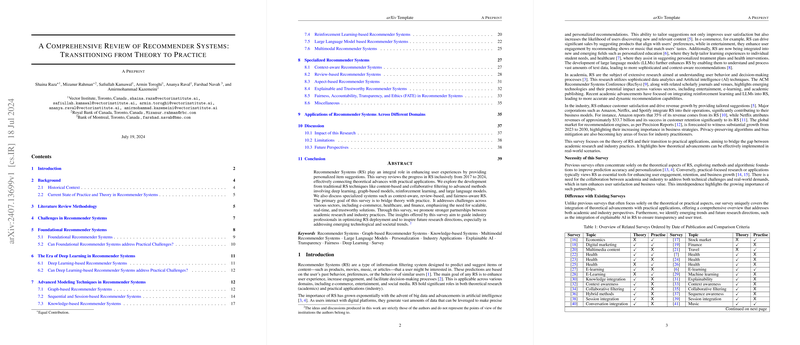A Comprehensive Review of Recommender Systems: Transitioning from Theory to Practice
Recommender Systems (RS) have become an indispensable tool in various sectors, providing tailored suggestions to enhance user experience. The paper "A Comprehensive Review of Recommender Systems: Transitioning from Theory to Practice" by Shaina Raza et al., offers an extensive survey of the developments and advancements in RS from 2017 to 2024. This survey bridges the gap between theoretical foundations and practical applications, highlighting the intersection of academic research and industry practices.
Abstract and Key Contributions
The paper emphasizes the crucial role of RS in enriching user experiences by delivering personalized recommendations. It covers a wide spectrum of RS methodologies, from traditional techniques like content-based (CB) and collaborative filtering (CF) to advanced approaches involving deep learning, graph-based models, reinforcement learning (RL), and LLMs. Furthermore, the survey explores niche areas, including context-aware, review-based, and fairness-aware RS. One of the core objectives is to foster stronger collaborations between academia and industry by translating theoretical innovations into practical, scalable, and trustworthy solutions.
Key contributions of this survey include:
- Comprehensive Review: Tracing the evolution of RS over seven years and detailing both theoretical foundations and practical applications.
- Detailed Examination: Analysis of various types of RS, including data inputs, challenges, relevant datasets, evaluation metrics, model accuracy, and applications.
- Sector-specific Challenges: Discussion of distinct RS challenges in e-commerce, healthcare, finance, and other sectors, advocating for scalable and privacy-focused implementations.
Theoretical Foundations and Evolution
Traditional Recommender Systems
The survey starts with foundational RS methods, categorizing them into CB, CF, and hybrid approaches. These systems lay the groundwork for personalized recommendations by leveraging user behavior and item characteristics. Techniques such as matrix factorization, k-nearest neighbors, and simple neural networks have historically driven RS development.
- Content-Based Filtering (CBF): Utilizes item features and user profiles to recommend similar items. It relies on methods like TF-IDF and cosine similarity but faces limitations like over-specialization and scalability issues.
- Collaborative Filtering (CF): Predicts user preferences based on the behavior of similar users. CF includes user-based and item-based approaches, evolving into more sophisticated models like matrix factorization to address sparsity and cold-start problems.
- Hybrid Approaches: Integrate CBF and CF to leverage the strengths of both, enhancing recommendation accuracy and diversity.
Deep Learning in Recommender Systems
Deep learning models have revolutionized RS by capturing complex user-item interactions through neural networks. The paper explores various deep-learning-based RS:
- Multi-Layer Perceptrons (MLPs): Improve non-linear interaction modeling but can be complex and prone to overfitting.
- Autoencoders: Facilitate dimensionality reduction and noise mitigation in data, enhancing RS performance in sparse environments.
- Convolutional Neural Networks (CNNs): Excel in learning from multimodal data, such as images and text, making them suitable for diverse recommendation contexts.
- Recurrent Neural Networks (RNNs): Capture temporal dynamics in sequential and session-based RS, addressing short-term user preferences effectively.
Advanced Modeling Techniques
The survey highlights cutting-edge techniques, including graph-based, sequential, knowledge-based, and RL models:
Graph-based Recommender Systems
GNNs are employed to model complex relational data, capturing user-item interactions more accurately. These models include:
- Graph Convolutional Matrix Completion (GC-MC): Applies deep learning to user-item interaction graphs.
- Neural Graph Collaborative Filtering (NGCF): Integrates collaborative signals into embeddings.
- Knowledge Graph Attention Network (KGAT): Uses knowledge graphs for more diverse and explainable recommendations.
Sequential and Session-based Recommender Systems
Sequential RS leverage user interaction history, predicting future behavior by employing models like:
- GS-SASRec: A self-attention based model that captures long-term user semantics.
- GRU4Rec: Uses Gated Recurrent Units for session-based recommendations, improving real-time recommendation accuracy.
LLMs
The incorporation of LLMs has significantly enhanced RS performance by understanding and processing vast text data, contributing to more context-aware recommendations. Enhancements with transformers have led to improved user representation and personalization.
Specialized Recommender Systems
The paper discusses specialized RS that address sector-specific requirements, including:
- Context-aware Recommender Systems (CARS): Integrate contextual information like time and location for more relevant recommendations, utilizing models like xDeepFM and Attentional Factorization Machine (AFM).
- Review-based Recommender Systems: Analyze user reviews to refine recommendations, employing techniques like DeepCoNN and NARRE.
- Aspect-based Recommender Systems: Focus on specific product attributes, enhancing recommendations through models like Aspect-based Neural Recommender (ANR).
Practical Implications and Future Directions
The comprehensive survey identifies several key trends and future directions:
- Fairness, Accountability, Transparency, and Ethics (FATE): Emphasizes the importance of ethical considerations in RS, ensuring fairness and mitigating biases.
- Scalability and Real-time Performance: Highlights the need for scalable and real-time RS solutions to handle vast user data and dynamic preferences.
- Explainability: Calls for improving the interpretability of RS to enhance user trust and satisfaction.
Conclusion
The paper by Shaina Raza et al. offers a thorough examination of RS, bridging theoretical advances with practical implementations. By addressing sector-specific challenges, it provides a roadmap for future research and industry applications, promoting the development of scalable, real-time, and trustworthy RS solutions. This survey serves as a valuable resource for both academic researchers and industry professionals seeking to optimize RS deployment and inspire future research directions in addressing emerging technological and societal trends.
